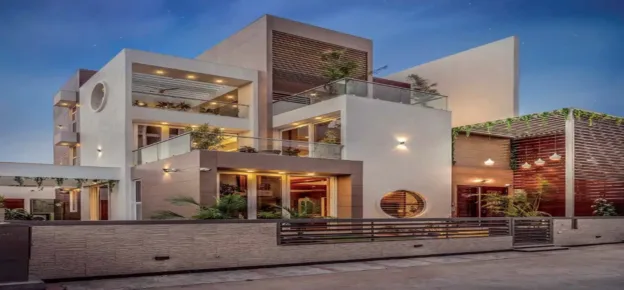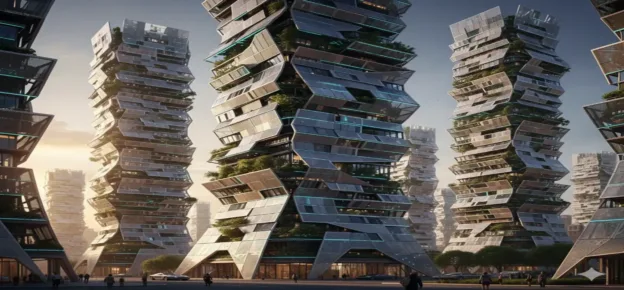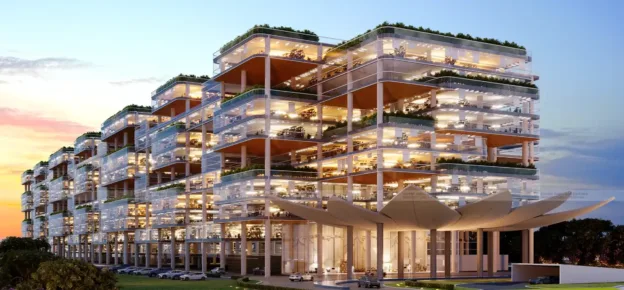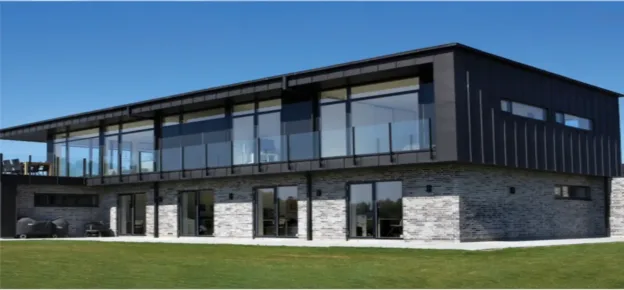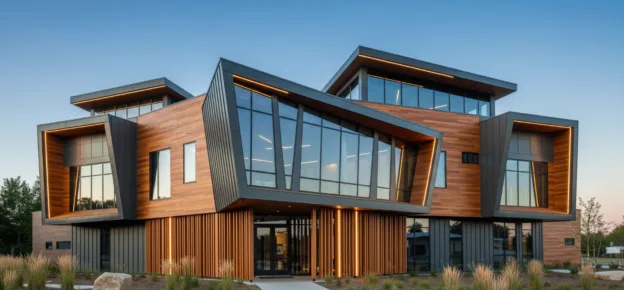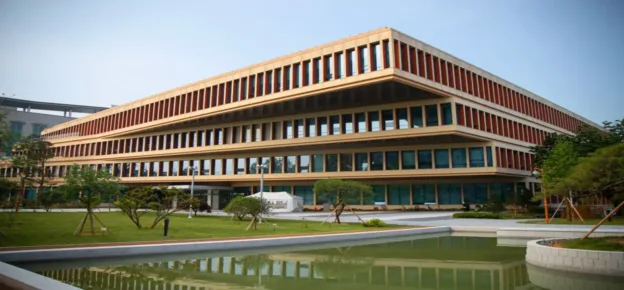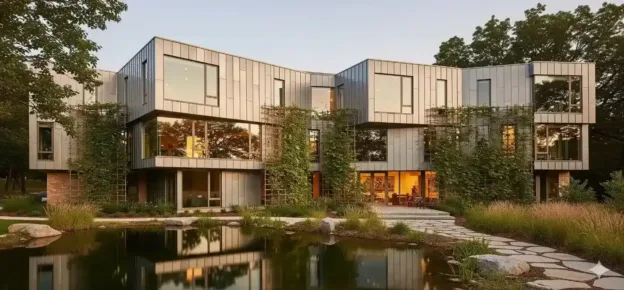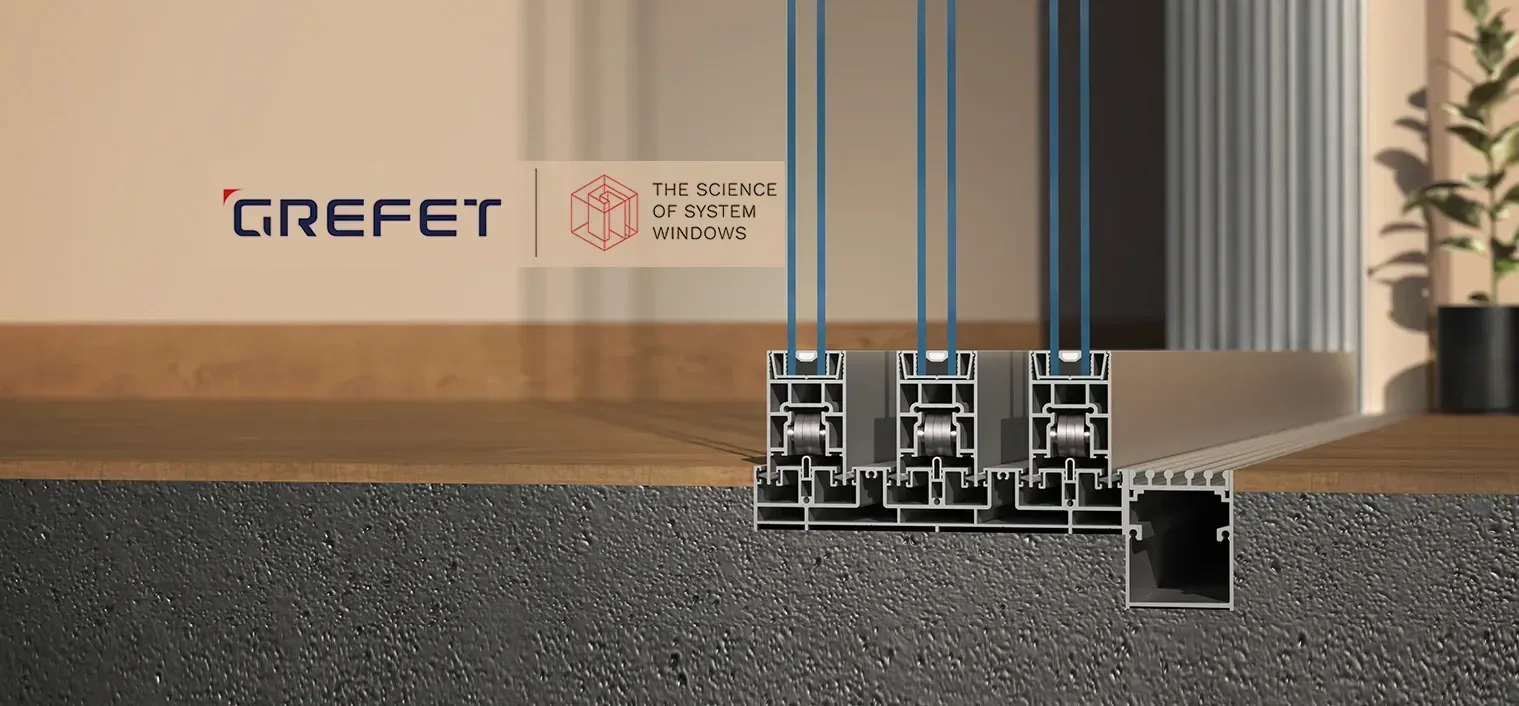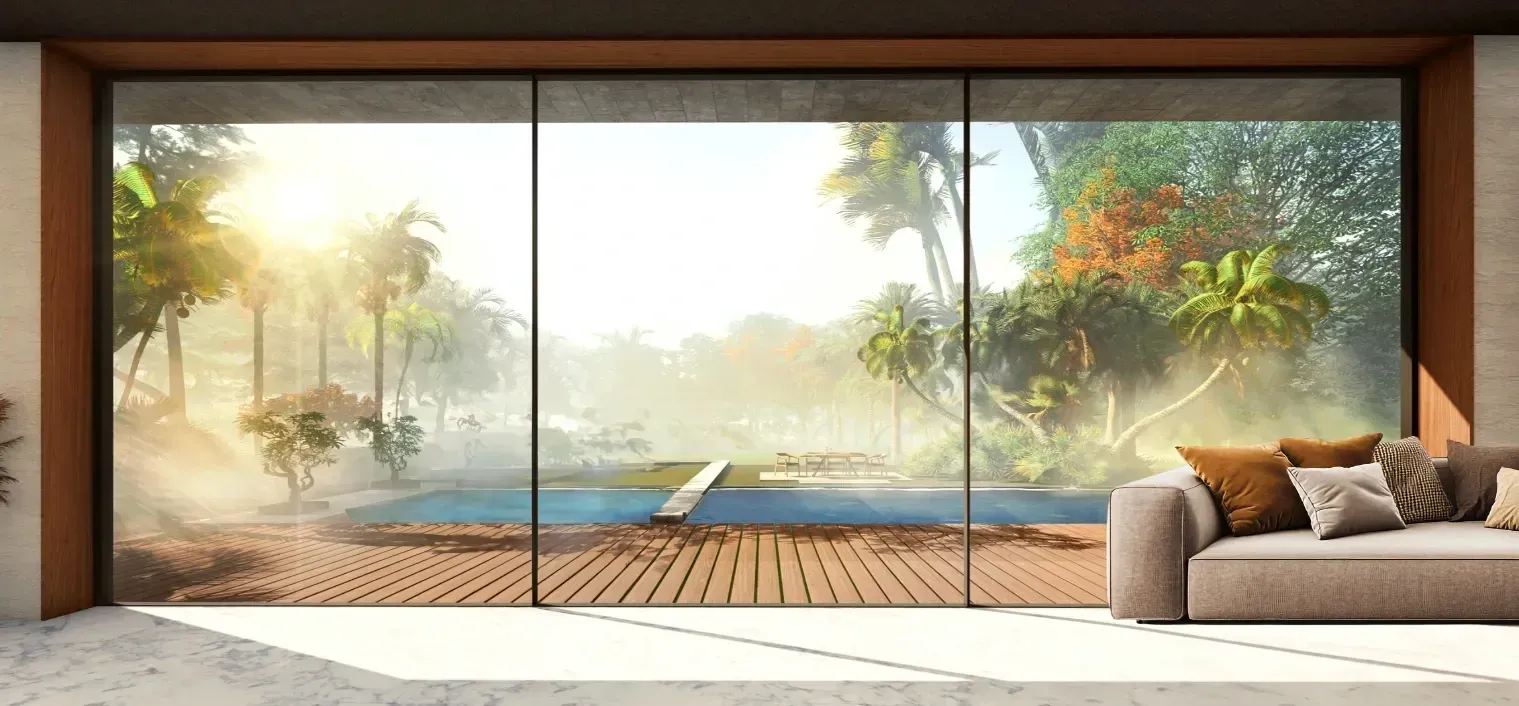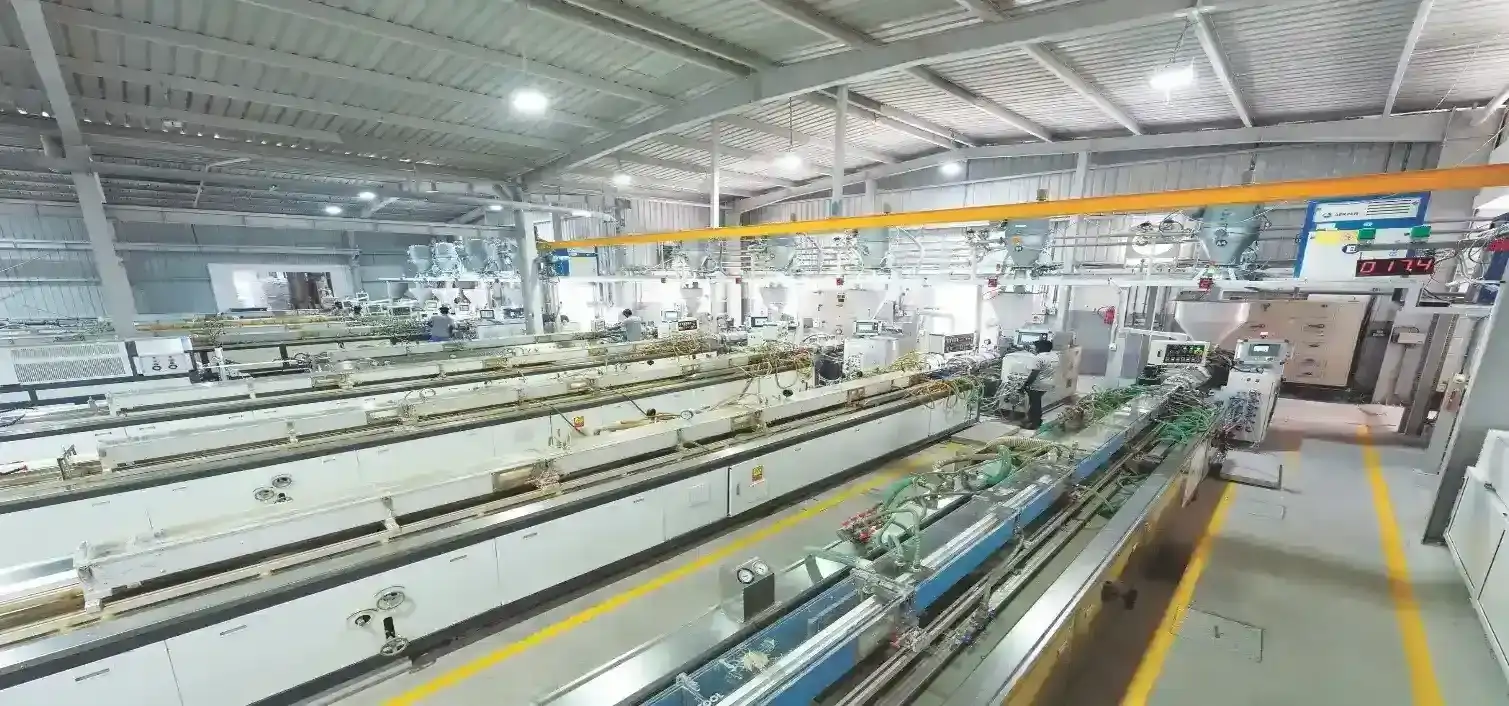Smart & Environmentally Responsible Choices
Cladding of buildings is one of the most expressive, inspiring and complex aspects of building design. The basic function of an envelope or enclosure of a building or structure is to protect the covered or otherwise conditioned interior spaces from the surrounding environment. Cladding is the application of one material over another to provide skin or layer intended to control the infiltration of weather elements, or for aesthetic purposes.

The façade is required to fulfil a wide range of technical and architectural roles, including weather tightness and structural. The cladding has to protect a building from moisture and wind and is an integral part of a wall assembly, responsible in surprising ways for a building’s overall thermal performance.

A wholesome building should provide an acceptable level of thermal comfort with minimal environmental impact. The façade and cladding industry has gone through a sea change in the past decade. The market is flooded with materials of different textures and colours. WFM Media spoke to many experts in the construction sector, including architects, façade consultants, manufacturers of cladding materials and civil engineers on the advancement in the cladding sector and the newest in cladding technology and materials. Here is what experts have to say about the latest in the industry.
EXTERIOR CLADDING MATERIALS – IMPACT ON BUILDING’S COMFORT AND SUSTAINABILITY

Cladding materials play a critical role in creating a comfortable and sustainable building. According to Ar. Vikrant Sharma, Founding Partner and Principal Architect, Hivemind Design LLP, exterior cladding materials reduce heat gain and provide insulation, regulating interior temperature and minimising energy consumption. Additionally, these materials ensure a comfortable temperature inside by controlling heat transfer and reducing the energy footprint of the building.

Cladding acts like a building’s thermal envelope, says Ar. Gagandeep Kapila, Co-Founder & Principal Architect, WMA. “We prioritise materials with high thermal resistance, like insulated concrete panels or rainscreen systems. These create a barrier, reducing heat transfer in summer and heat loss in winter. This translates to a comfortable interior environment while minimising energy use for heating, ventilation, and air conditioning (HVAC) systems. We also explore materials like terracotta or fibre cement that offer natural ventilation through their breathability, further reducing reliance on mechanical cooling”, adds Ar. Kapila.
Bakul Chandra, Co-founder, Mentor & Design Strategist, at Renascent Consultants, adds that exterior cladding materials play a crucial role in determining interior comfort and sustainability by providing insulation, weather protection, solar heat control, durability, moisture management, and aesthetic enhancement. The choice of environment-friendly and energy-efficient cladding options can significantly improve the overall performance and sustainability of any building.
INNOVATIVE AND HIGH-DEMAND CLADDING MATERIALS
The world of cladding is constantly evolving, and we’re excited about some innovative materials. Prefabricated lightweight aggregate concrete (PLAAC) panels are gaining traction, reveals Ar. Kapila. These offer superior insulation due to air gaps within the panels and allow for rapid construction due to prefabrication. Bio-composite cladding, made from recycled materials like wood fibres and natural resins, is another favourite. It boasts excellent sustainability credentials and a unique aesthetic, making it a win-win for design and the environment, adds Ar. Kapila.

Innovative materials are used to reshape exterior cladding in architecture while meeting sustainability objectives. According to Ar. Vikrant Sharma, perforated meshes are in high demand as they offer versatile applications. A great way to use them is as a Jaali, which can be used over solid and glass façades. Stone is used mainly when dry-clad, as advancements in CNC milling techniques have also made it easier to develop intricate designs.

“We at Hive prefer lightweight porcelain tiles like those offered by Laminam. They address modern needs with durability and design flexibility. Laminam and many other brands’ commitment to sustainability is evident in their continuous improvements. There is a global trend towards responsible purchasing practices, and our sustainable choices align with those trends”, adds Ar. Sharma. According to Chandra, some of the innovative materials for exterior cladding gaining popularity due to their sustainability, durability, and aesthetic appeal are Fibre Cement, Reclaimed Wood, Metal Panels, High-Pressure Laminate (HPL), Glass Reinforced Concrete (GRC) and Natural Stone Veneer.
Bio-based Materials such as bamboo, cork, or recycled plastic are also emerging as eco-friendly options for exterior cladding. Their respective demand often depends on personal preferences, architectural trends, and sustainability goals. However, materials that offer a combination of sustainability, durability, and design flexibility tend to be highly sought after in the current market. Additionally, materials with low maintenance requirements and energy-efficient properties are also gaining popularity
APPROPRIATE CLADDING FOR ENERGY EFFICIENCY, BETTER ACOUSTICS AND OPTIMAL DAYLIGHTING
Façade cladding can be strategically used to achieve significant energy efficiency and cost-effectiveness of buildings. Additionally, cladding materials play a crucial role in acoustics, with some materials absorbing sound to improve the indoor ambience.

Ar. Kavita Batra, a graduate of DCRUST and the principal architect of the firm Unifyy, says that the façade cladding enhances energy efficiency by providing insulation and reducing heat transfer, thereby lowering heating and cooling costs. Different materials impact acoustics differently; for instance, porous materials like wood may absorb sound, while metal may reflect it. Cladding designs can also affect daylighting, with features like larger windows or reflective surfaces maximising natural light penetration. Properly selected cladding materials mitigate heat ingress, maintaining comfortable indoor temperatures and reducing reliance on HVAC systems. Overall, strategic cladding choices contribute to energy conservation, cost savings, and improved indoor environmental quality.
Modern cladding trends prioritise materials like zinc, porcelain, and composite panels, blending durability with architectural elegance. Neutral colour palettes with subtle variations are popular choices for cladding finishes, imparting a timeless and sophisticated appearance. Dynamic cladding designs integrate geometric shapes and asymmetrical compositions, creating visually striking façades that stand out in urban landscapes.
Metal panels with a high Solar Reflective Index (SRI) reflect sunlight, reducing heat gain within the building, notes Ar. Kapila. Cladding systems with proper air cavities promote natural ventilation, further lowering cooling needs. “We should also consider acoustics during the design phase. Materials like wood or fabric panels have sound-absorbing and diffusing properties, creating a quieter and more productive environment for occupants. Further, the integration of overhangs or fins on the façade controls daylight penetration. This optimises natural light while minimising glare and heat gain,” says Ar. Kapila.

Ar. Sharma agrees that façade cladding acts as a protective barrier, providing insulation to regulate indoor temperature and reduce the need for excessive heating or cooling. This insulation capability not only enhances comfort but also lowers energy consumption, thereby reducing utility costs. Certain materials with high thermal reflectivity help mitigate the urban heat island effect, leading to a cooler environment and further energy conservation. By carefully selecting cladding materials based on their thermal properties, acoustic characteristics, and sustainability factors, architects and builders can create environmentally friendly and economically viable buildings, ensuring long-term benefits for occupants and the environment alike, explains Ar. Sharma.
What are the effects of cladding materials on acoustics, daylighting, heat ingress, and energy conservation?
The choice of façade cladding materials and their use in design strategies directly impact energy efficiency, indoor comfort, and cost-effectiveness of buildings by influencing insulation, air tightness, solar heat gain, daylighting, acoustics, and maintenance requirements. By selecting appropriate cladding solutions that prioritise energy conservation and occupant comfort, building owners can achieve significant long-term savings while creating sustainable and high-performing built environments, says Chandra.
THE TRENDS IN CLADDING DESIGN, MATERIALS, AND COLOURS

There’s a resurgence of natural materials in cladding design. Wood with advanced finishes for durability and weather resistance is making a comeback. We’re also seeing a rise in textured metal panels that offer a contemporary aesthetic. However, observes Ar. Kapila, the most exciting trend is the integration of biophilic design principles. Vertical gardens or planter systems incorporated into the façade create a connection to nature and enhance building aesthetics.
Ar. Sharma also agrees that metal has emerged as a prominent choice, prised for its durability, versatility, and customisable nature. From solid panels to perforated or faceted designs, metal offers a plethora of options to suit various architectural styles. Additionally, the availability of different finishes adds to its appeal. It’s also lighter than stone cladding.
Wood replicating polymers and reconstituted wood have also gained popularity, offering a natural aesthetic with good thermal properties. Slatted panels or screens mimic the look of wood while providing durability and ease of maintenance. While not as customisable as metal, wood cladding adds warmth and texture to building exteriors.
Chandra says that there is a growing preference for environmentally friendly cladding materials, such as reclaimed wood, recycled metal, and bio-based composites with textured finishes are being used to add visual interest and depth to façades. Biophilic colours, earth tones and dark hues are trending for creating striking contrasts and contemporary aesthetics. Metallic Finishes are adding a touch of luxury and sophistication to modern architectural designs. Clean lines and minimalist profiles are favoured for achieving a sleek and contemporary look, with an emphasis on simplicity and understated elegance. Geometric patterns and asymmetrical designs are being used to create dynamic façades that play with light and shadow. This reflects an overall emphasis on creating visually striking yet functional building exteriors.

CLADDING MATERIALS DIFFER BASED ON BUILDING TYPE
The choice of cladding materials differs according to the specific building type. The prevailing trend across all sectors is uniqueness; we also prefer deviating from standardised approaches to create distinct façades reflecting each building’s identity. Customisation is the key for us, allowing for unique designs tailored to specific project requirements. Whether it’s a residential neighbourhood or a bustling commercial complex, cladding choices are driven by a desire for individuality and innovation.

Residential buildings often benefit from warm and inviting materials like wood or stone veneer that create a sense of character. In contrast, commercial spaces might utilise metal panels, glass façades, or fibre cement for a sleek and modern look that reflects professionalism. Healthcare facilities prioritise a calming and serene environment, so we might use light-coloured materials like precast concrete panels or terracotta rainscreen systems to achieve this ambience, explains Ar. Kapila.
Ar. Sharma, too agrees that residential settings often favour traditional materials like stone, and commercial and institutional buildings increasingly opt for composite metal panels due to their durability and versatility.
Chandra observes that trends in cladding for different end-use applications reflect a combination of functional requirements, aesthetic preferences, and sustainability goals specific to each building type. In residential buildings, natural & sustainable materials with modern aesthetics and biophilic design character are preferred. In commercial buildings, high-performance materials which may reflect the brand identity and a dynamic façade are preferred. In commercial buildings, durable and low-maintenance materials with diverse aesthetics are preferred. In healthcare buildings, hygienic and anti-microbial materials that promote healing and well-being are preferred. In office buildings, smart and sustainable solutions, including energy-efficient glazing, solar shading devices, and integrated building management system,s are preferred. Lastly, in industrial buildings, robust and protective materials with minimum maintenance are preferred.

Ar. Mukesh Bhatia, MD, SSB Architects, notes that exterior cladding materials significantly influence interior comfort and sustainability by regulating thermal performance, moisture management, and indoor air quality. Sustainable cladding options, such as natural wood or recycled materials, contribute to a healthier indoor environment and reduce energy consumption. Properly selected cladding materials enhance insulation, mitigating heat loss or gain and minimising the need for mechanical heating or cooling systems.
Moreover, cladding materials impact acoustic properties, daylighting levels, and overall energy conservation within the building. By prioritising sustainable and high-performance cladding solutions, architects can create spaces that promote occupant well-being, minimise environmental impact, and optimise long-term sustainability. High-performance materials like insulated metal panels (IMPs), terracotta, and bio-based composites are experiencing increased demand for exterior cladding applications.
IMPs provide excellent thermal insulation and weather resistance, making them ideal for energy-efficient building envelopes. Terracotta cladding offers timeless aesthetics, durability, and sustainability, making it a popular choice for contemporary architecture. Bio-based composites, derived from renewable sources like agricultural waste or biopolymers, offer a sustainable alternative to traditional cladding materials while providing comparable performance. These innovative materials address the growing demand for sustainable building solutions while offering architects versatile options for exterior cladding.

FIRE SAFETY STANDARDS FOR CLADDING MATERIALS
Fire safety is a top priority when it comes to choosing cladding materials. We only use cladding materials that meet or exceed stringent fire resistance ratings established by local building codes, says Ar. Kapila. This might involve using non-combustible materials or cladding systems with fire-resistant barriers. However, safety goes beyond fire. We consider materials resistant to vandalism and those that contribute to the overall security of the building.
Fire safety standards for cladding materials prioritise non-combustible options, ensuring the entire cladding system remains non-combustible to prevent the spread of fire and smoke through the façade, notes Ar. Sharma. The Grenfell Tower tragedy highlighted the need for stringent fire safety regulations, prompting a global revaluation of cladding materials even here in India. Other concerns regarding cladding materials include structural integrity and weather resistance. Measures such as fire-resistant barriers and proper installation techniques are crucial to safeguarding buildings and occupants.

According to Chandra, safety concerns related to cladding materials primarily revolve around fire safety, structural integrity, and health hazards. Addressing safety concerns concerning cladding materials requires careful selection, proper design, quality installation, ongoing maintenance, and adherence to regulatory requirements. Collaboration among architects, engineers, contractors, and building owners is essential to mitigate risks and ensure the safety and integrity of building façades.
Typically, cladding materials:
- Should be assessed for their fire resistance & ability to prevent the spread of fire;
- Must be designed & installed to withstand various loads, including wind, snow, seismic forces, and impact; and,
- Materials that may release harmful substances or volatile organic compounds (VOCs) into the indoor environment, posing health risks to occupants, should be avoided or properly managed to mitigate health hazards.

Ar. Prashant Kochhar, Founder and Principal Architect of LTDF, opines that exterior cladding materials play a vital role in determining interior comfort and sustainability by providing insulation, weather protection, and aesthetic appeal. Sustainable cladding options, such as recycled metal panels or fibre cement, contribute to energy efficiency and reduce the building’s carbon footprint. Also, cladding materials influence acoustic performance, daylighting levels, and thermal comfort within the building. By selecting cladding materials with high thermal resistance and low environmental impact, architects can improve energy efficiency and indoor environmental quality.
Furthermore, innovative cladding solutions, like green walls or photovoltaic cladding, offer opportunities to integrate renewable energy generation and biophilic design principles, further enhancing the building’s sustainability credentials. Innovative materials such as cross-laminated timber (CLT), photovoltaic cladding, and recycled metal panels are in high demand for exterior cladding applications. CLT offers structural stability, thermal performance, and aesthetic appeal, making it a versatile choice for sustainable construction. Photovoltaic cladding integrates solar cells into building façades, enabling renewable energy generation while providing weather protection and design flexibility.
Recycled metal panels, made from reclaimed materials like aluminium or steel, offer durability, corrosion resistance, and environmental benefits. These innovative materials align with the increasing emphasis on sustainability in the construction industry, offering architects and developers practical solutions for energy-efficient and environmentally friendly building envelopes.

Ar. Rajkumar Kumawat, Founder and Principal Architect, Rajkumar Architects, observes that cladding trends are a reflection of society’s evolving tastes and aspirations, blending tradition with innovation to create visually stunning façades. Sustainable materials like reclaimed timber and recycled metal panels are having a moment, adding character and texture to buildings while championing environmental responsibility. Meanwhile, bold colours and geometric patterns are making a comeback, injecting personality and vibrancy into urban landscapes.
Architects are pushing the boundaries of design with dynamic façades that respond to their surroundings, blurring the lines between art and architecture. As buildings become canvases for self-expression, cladding trends continue to evolve, celebrating diversity and creativity in the built environment. Cladding trends vary across different sectors, reflecting unique needs and design philosophies. In residential architecture, there’s a resurgence of interest in natural materials like stone and timber, evoking a sense of tranquillity and connection with nature. Commercial buildings often feature sleek and minimalist cladding designs, projecting a contemporary and professional image.
Healthcare facilities prioritise functionality and hygiene, opting for durable materials like stainless steel and antibacterial coatings. Offices are embracing biophilic design principles, incorporating living walls and green façades to promote employee well-being. Industrial structures prioritise durability and resilience, with materials like corrugated metal and reinforced concrete offering robust solutions for demanding environments.


Talking about Fire safety standards, Ridhima Singh, Founder and Creative Director, Danza Del Design, points out that fire safety standards for cladding materials are essential to protect the building and its occupants from the spread of fire. Materials with high fire resistance, such as ceramic tiles and stone cladding, are preferred for their ability to withstand flames and prevent fire spread. Other safety concerns include the structural integrity of the cladding system, its resistance to impact and wind loads, and its vulnerability to water ingress or corrosion, all of which can compromise the safety and security of the building.
In the future, we strongly expect the use of biodegradable and recyclable cladding materials such as bio-based polymers and mycelium composites, offering sustainable alternatives to traditional materials. Innovative designs incorporating kinetic façades and responsive cladding systems will enhance the interactive and adaptive capabilities of buildings, responding dynamically to changing environmental conditions and user needs.
FUTURE CLADDING MATERIALS

The future of cladding is intelligent and adaptive. Imagine self-healing materials that automatically repair minor cracks or cladding systems that dynamically adjust their properties throughout the day to optimise natural light and ventilation. Furthermore, points Ar. Kapila, the integration of sensors and actuators within cladding systems for remote monitoring and performance optimisation is a concept with immense potential. This would allow for real-time adjustments to the building’s envelope, further enhancing comfort, sustainability, and overall building performance.
“In the next 25 years, I hope to see a shift towards more sustainable cladding materials like recycled options and composite stones made from construction waste. Incorporating solar energy generation into cladding systems for electricity would be fantastic. And I’m excited about technological advancements which could revolutionise how buildings function, like cladding materials utilising solar energy and not only storing electricity”, Ar. Sharma is hopeful.
According to Chandra, predicting specific types of cladding materials and designs in the future is challenging. However, some potential types of cladding materials and designs to look out for are smart materials, carbon-neutral materials, 3D printed materials, nanoengineered materials with enhanced properties, transparent solar panels and the use of bio-materials and bio-fabrication.
While these speculative trends offer insights into potential future directions for cladding materials and designs, it’s important to recognise that technological, economic, and cultural factors will ultimately shape the trajectory of innovation in the built environment over the next 25 years.

